+ Open data
Open data
- Basic information
Basic information
| Entry | Database: PDB / ID: 6l4u | |||||||||||||||||||||
|---|---|---|---|---|---|---|---|---|---|---|---|---|---|---|---|---|---|---|---|---|---|---|
| Title | Structure of the PSI-FCPI supercomplex from diatom | |||||||||||||||||||||
 Components Components |
| |||||||||||||||||||||
 Keywords Keywords | ELECTRON TRANSPORT / Photosystem I | |||||||||||||||||||||
| Function / homology |  Function and homology information Function and homology informationChem-A86 / BETA-CAROTENE / CHLOROPHYLL A ISOMER / CHLOROPHYLL A / Chem-DD6 / Chlorophyll c1 / 1,2-DIPALMITOYL-PHOSPHATIDYL-GLYCEROLE / 1,2-DISTEAROYL-MONOGALACTOSYL-DIGLYCERIDE / PHYLLOQUINONE / IRON/SULFUR CLUSTER Similarity search - Component | |||||||||||||||||||||
| Biological species |  Chaetoceros gracilis (Diatom) Chaetoceros gracilis (Diatom) | |||||||||||||||||||||
| Method | ELECTRON MICROSCOPY / single particle reconstruction / cryo EM / Resolution: 2.4 Å | |||||||||||||||||||||
 Authors Authors | Nagao, R. / Kato, K. / Miyazaki, N. / Akita, F. / Shen, J.R. | |||||||||||||||||||||
 Citation Citation |  Journal: Nat Commun / Year: 2020 Journal: Nat Commun / Year: 2020Title: Structural basis for assembly and function of a diatom photosystem I-light-harvesting supercomplex. Authors: Ryo Nagao / Koji Kato / Kentaro Ifuku / Takehiro Suzuki / Minoru Kumazawa / Ikuo Uchiyama / Yasuhiro Kashino / Naoshi Dohmae / Seiji Akimoto / Jian-Ren Shen / Naoyuki Miyazaki / Fusamichi Akita /  Abstract: Photosynthetic light-harvesting complexes (LHCs) play a pivotal role in collecting solar energy for photochemical reactions in photosynthesis. One of the major LHCs are fucoxanthin chlorophyll a/c- ...Photosynthetic light-harvesting complexes (LHCs) play a pivotal role in collecting solar energy for photochemical reactions in photosynthesis. One of the major LHCs are fucoxanthin chlorophyll a/c-binding proteins (FCPs) present in diatoms, a group of organisms having important contribution to the global carbon cycle. Here, we report a 2.40-Å resolution structure of the diatom photosystem I (PSI)-FCPI supercomplex by cryo-electron microscopy. The supercomplex is composed of 16 different FCPI subunits surrounding a monomeric PSI core. Each FCPI subunit showed different protein structures with different pigment contents and binding sites, and they form a complicated pigment-protein network together with the PSI core to harvest and transfer the light energy efficiently. In addition, two unique, previously unidentified subunits were found in the PSI core. The structure provides numerous insights into not only the light-harvesting strategy in diatom PSI-FCPI but also evolutionary dynamics of light harvesters among oxyphototrophs. | |||||||||||||||||||||
| History |
|
- Structure visualization
Structure visualization
| Movie |
 Movie viewer Movie viewer |
|---|---|
| Structure viewer | Molecule:  Molmil Molmil Jmol/JSmol Jmol/JSmol |
- Downloads & links
Downloads & links
- Download
Download
| PDBx/mmCIF format |  6l4u.cif.gz 6l4u.cif.gz | 1.4 MB | Display |  PDBx/mmCIF format PDBx/mmCIF format |
|---|---|---|---|---|
| PDB format |  pdb6l4u.ent.gz pdb6l4u.ent.gz | Display |  PDB format PDB format | |
| PDBx/mmJSON format |  6l4u.json.gz 6l4u.json.gz | Tree view |  PDBx/mmJSON format PDBx/mmJSON format | |
| Others |  Other downloads Other downloads |
-Validation report
| Summary document |  6l4u_validation.pdf.gz 6l4u_validation.pdf.gz | 20.4 MB | Display |  wwPDB validaton report wwPDB validaton report |
|---|---|---|---|---|
| Full document |  6l4u_full_validation.pdf.gz 6l4u_full_validation.pdf.gz | 22.7 MB | Display | |
| Data in XML |  6l4u_validation.xml.gz 6l4u_validation.xml.gz | 444.7 KB | Display | |
| Data in CIF |  6l4u_validation.cif.gz 6l4u_validation.cif.gz | 518.3 KB | Display | |
| Arichive directory |  https://data.pdbj.org/pub/pdb/validation_reports/l4/6l4u https://data.pdbj.org/pub/pdb/validation_reports/l4/6l4u ftp://data.pdbj.org/pub/pdb/validation_reports/l4/6l4u ftp://data.pdbj.org/pub/pdb/validation_reports/l4/6l4u | HTTPS FTP |
-Related structure data
| Related structure data |  0835MC  0834C  6l4tC C: citing same article ( M: map data used to model this data |
|---|---|
| Similar structure data |
- Links
Links
- Assembly
Assembly
| Deposited unit | 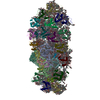
|
|---|---|
| 1 |
|
- Components
Components
-Photosystem I P700 chlorophyll a apoprotein ... , 2 types, 2 molecules AB
| #1: Protein | Mass: 83648.672 Da / Num. of mol.: 1 / Source method: isolated from a natural source / Source: (natural)  Chaetoceros gracilis (Diatom) Chaetoceros gracilis (Diatom) |
|---|---|
| #2: Protein | Mass: 81897.477 Da / Num. of mol.: 1 / Source method: isolated from a natural source / Source: (natural)  Chaetoceros gracilis (Diatom) Chaetoceros gracilis (Diatom) |
-Protein , 2 types, 2 molecules C1u
| #3: Protein | Mass: 8807.169 Da / Num. of mol.: 1 / Source method: isolated from a natural source / Source: (natural)  Chaetoceros gracilis (Diatom) Chaetoceros gracilis (Diatom) |
|---|---|
| #11: Protein | Mass: 11081.651 Da / Num. of mol.: 1 / Source method: isolated from a natural source / Source: (natural)  Chaetoceros gracilis (Diatom) Chaetoceros gracilis (Diatom) |
-Photosystem I reaction center subunit ... , 8 types, 8 molecules DEFIJLM2u
| #4: Protein | Mass: 15594.646 Da / Num. of mol.: 1 / Source method: isolated from a natural source / Source: (natural)  Chaetoceros gracilis (Diatom) Chaetoceros gracilis (Diatom) |
|---|---|
| #5: Protein | Mass: 7621.467 Da / Num. of mol.: 1 / Source method: isolated from a natural source / Source: (natural)  Chaetoceros gracilis (Diatom) Chaetoceros gracilis (Diatom) |
| #6: Protein | Mass: 20445.615 Da / Num. of mol.: 1 / Source method: isolated from a natural source / Source: (natural)  Chaetoceros gracilis (Diatom) Chaetoceros gracilis (Diatom) |
| #7: Protein/peptide | Mass: 3944.740 Da / Num. of mol.: 1 / Source method: isolated from a natural source / Source: (natural)  Chaetoceros gracilis (Diatom) Chaetoceros gracilis (Diatom) |
| #8: Protein/peptide | Mass: 4882.824 Da / Num. of mol.: 1 / Source method: isolated from a natural source / Source: (natural)  Chaetoceros gracilis (Diatom) Chaetoceros gracilis (Diatom) |
| #9: Protein | Mass: 16148.812 Da / Num. of mol.: 1 / Source method: isolated from a natural source / Source: (natural)  Chaetoceros gracilis (Diatom) Chaetoceros gracilis (Diatom) |
| #10: Protein/peptide | Mass: 3241.863 Da / Num. of mol.: 1 / Source method: isolated from a natural source / Source: (natural)  Chaetoceros gracilis (Diatom) Chaetoceros gracilis (Diatom) |
| #12: Protein | Mass: 12899.798 Da / Num. of mol.: 1 / Source method: isolated from a natural source / Source: (natural)  Chaetoceros gracilis (Diatom) Chaetoceros gracilis (Diatom) |
-Fucoxanthin chlorophyll a/c-binding protein ... , 16 types, 16 molecules 12345678910111213141516
| #13: Protein | Mass: 24881.914 Da / Num. of mol.: 1 / Source method: isolated from a natural source / Source: (natural)  Chaetoceros gracilis (Diatom) Chaetoceros gracilis (Diatom) |
|---|---|
| #14: Protein | Mass: 21727.959 Da / Num. of mol.: 1 / Source method: isolated from a natural source / Source: (natural)  Chaetoceros gracilis (Diatom) Chaetoceros gracilis (Diatom) |
| #15: Protein | Mass: 21558.555 Da / Num. of mol.: 1 / Source method: isolated from a natural source / Source: (natural)  Chaetoceros gracilis (Diatom) Chaetoceros gracilis (Diatom) |
| #16: Protein | Mass: 22933.426 Da / Num. of mol.: 1 / Source method: isolated from a natural source / Source: (natural)  Chaetoceros gracilis (Diatom) Chaetoceros gracilis (Diatom) |
| #17: Protein | Mass: 29512.191 Da / Num. of mol.: 1 / Source method: isolated from a natural source / Source: (natural)  Chaetoceros gracilis (Diatom) Chaetoceros gracilis (Diatom) |
| #18: Protein | Mass: 22362.646 Da / Num. of mol.: 1 / Source method: isolated from a natural source / Source: (natural)  Chaetoceros gracilis (Diatom) Chaetoceros gracilis (Diatom) |
| #19: Protein | Mass: 32238.152 Da / Num. of mol.: 1 / Source method: isolated from a natural source / Source: (natural)  Chaetoceros gracilis (Diatom) Chaetoceros gracilis (Diatom) |
| #20: Protein | Mass: 29704.150 Da / Num. of mol.: 1 / Source method: isolated from a natural source / Source: (natural)  Chaetoceros gracilis (Diatom) Chaetoceros gracilis (Diatom) |
| #21: Protein | Mass: 23517.385 Da / Num. of mol.: 1 / Source method: isolated from a natural source / Source: (natural)  Chaetoceros gracilis (Diatom) Chaetoceros gracilis (Diatom) |
| #22: Protein | Mass: 22216.549 Da / Num. of mol.: 1 / Source method: isolated from a natural source / Source: (natural)  Chaetoceros gracilis (Diatom) Chaetoceros gracilis (Diatom) |
| #23: Protein | Mass: 24842.496 Da / Num. of mol.: 1 / Source method: isolated from a natural source / Source: (natural)  Chaetoceros gracilis (Diatom) Chaetoceros gracilis (Diatom) |
| #24: Protein | Mass: 21318.404 Da / Num. of mol.: 1 / Source method: isolated from a natural source / Source: (natural)  Chaetoceros gracilis (Diatom) Chaetoceros gracilis (Diatom) |
| #25: Protein | Mass: 25994.562 Da / Num. of mol.: 1 / Source method: isolated from a natural source / Source: (natural)  Chaetoceros gracilis (Diatom) Chaetoceros gracilis (Diatom) |
| #26: Protein | Mass: 26875.781 Da / Num. of mol.: 1 / Source method: isolated from a natural source / Source: (natural)  Chaetoceros gracilis (Diatom) Chaetoceros gracilis (Diatom) |
| #27: Protein | Mass: 30545.674 Da / Num. of mol.: 1 / Source method: isolated from a natural source / Source: (natural)  Chaetoceros gracilis (Diatom) Chaetoceros gracilis (Diatom) |
| #28: Protein | Mass: 23533.191 Da / Num. of mol.: 1 / Source method: isolated from a natural source / Source: (natural)  Chaetoceros gracilis (Diatom) Chaetoceros gracilis (Diatom) |
-Sugars , 1 types, 21 molecules 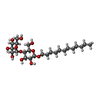
| #35: Sugar | ChemComp-LMT / |
|---|
-Non-polymers , 11 types, 562 molecules 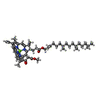

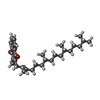




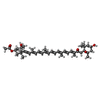
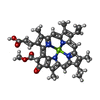












| #29: Chemical | ChemComp-CL0 / | ||||||||||||||||||
|---|---|---|---|---|---|---|---|---|---|---|---|---|---|---|---|---|---|---|---|
| #30: Chemical | ChemComp-CLA / #31: Chemical | #32: Chemical | #33: Chemical | ChemComp-BCR / #34: Chemical | ChemComp-LHG / #36: Chemical | ChemComp-LMG / #37: Chemical | ChemComp-A86 / ( #38: Chemical | ChemComp-KC1 / #39: Chemical | ChemComp-DD6 / ( #40: Water | ChemComp-HOH / | |
-Details
| Has ligand of interest | N |
|---|---|
| Has protein modification | Y |
-Experimental details
-Experiment
| Experiment | Method: ELECTRON MICROSCOPY |
|---|---|
| EM experiment | Aggregation state: PARTICLE / 3D reconstruction method: single particle reconstruction |
- Sample preparation
Sample preparation
| Component | Name: PSI-FCPI / Type: COMPLEX / Entity ID: #1-#28 / Source: NATURAL | |||||||||||||||
|---|---|---|---|---|---|---|---|---|---|---|---|---|---|---|---|---|
| Molecular weight | Value: 0.64 MDa / Experimental value: NO | |||||||||||||||
| Source (natural) | Organism:  Chaetoceros gracilis (Diatom) Chaetoceros gracilis (Diatom) | |||||||||||||||
| Buffer solution | pH: 6.5 | |||||||||||||||
| Buffer component |
| |||||||||||||||
| Specimen | Conc.: 2 mg/ml / Embedding applied: NO / Shadowing applied: NO / Staining applied: NO / Vitrification applied: YES | |||||||||||||||
| Specimen support | Grid material: MOLYBDENUM / Grid mesh size: 300 divisions/in. / Grid type: Quantifoil R1.2/1.3 | |||||||||||||||
| Vitrification | Instrument: FEI VITROBOT MARK IV / Cryogen name: ETHANE / Humidity: 100 % / Chamber temperature: 277 K |
- Electron microscopy imaging
Electron microscopy imaging
| Experimental equipment |  Model: Titan Krios / Image courtesy: FEI Company |
|---|---|
| Microscopy | Model: FEI TITAN KRIOS |
| Electron gun | Electron source:  FIELD EMISSION GUN / Accelerating voltage: 300 kV / Illumination mode: FLOOD BEAM FIELD EMISSION GUN / Accelerating voltage: 300 kV / Illumination mode: FLOOD BEAM |
| Electron lens | Mode: BRIGHT FIELD |
| Image recording | Electron dose: 50 e/Å2 / Detector mode: COUNTING / Film or detector model: FEI FALCON III (4k x 4k) |
- Processing
Processing
| EM software |
| ||||||||||||||||||||||||||||||||||||
|---|---|---|---|---|---|---|---|---|---|---|---|---|---|---|---|---|---|---|---|---|---|---|---|---|---|---|---|---|---|---|---|---|---|---|---|---|---|
| CTF correction | Type: PHASE FLIPPING AND AMPLITUDE CORRECTION | ||||||||||||||||||||||||||||||||||||
| Particle selection | Num. of particles selected: 2689965 | ||||||||||||||||||||||||||||||||||||
| Symmetry | Point symmetry: C1 (asymmetric) | ||||||||||||||||||||||||||||||||||||
| 3D reconstruction | Resolution: 2.4 Å / Resolution method: FSC 0.143 CUT-OFF / Num. of particles: 470801 / Algorithm: FOURIER SPACE / Symmetry type: POINT | ||||||||||||||||||||||||||||||||||||
| Atomic model building | Protocol: FLEXIBLE FIT / Space: REAL / Target criteria: Correlation coefficient |
 Movie
Movie Controller
Controller






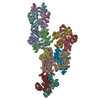
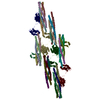
 PDBj
PDBj















